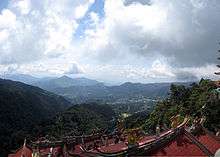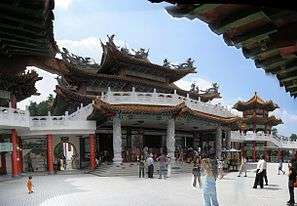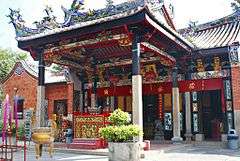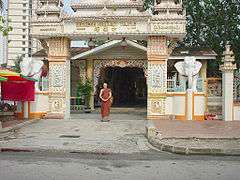Chin Swee Caves Temple
| Chin Swee Caves Temple | |||||||||||
|
Hall and pagoda of the Chin Swee Caves Temple | |||||||||||
| Chinese name | |||||||||||
|---|---|---|---|---|---|---|---|---|---|---|---|
| Traditional Chinese | 清水岩廟 | ||||||||||
| Simplified Chinese | 清水岩庙 | ||||||||||
| |||||||||||
| Malay name | |||||||||||
| Malay | Tokong Gua Chin Swee | ||||||||||

The Chin Swee Caves Temple is a Taoist temple in Genting Highlands, Pahang, Malaysia. The Chin Swee Caves Temple is situated in the most scenic site of Genting Highlands. Within the Temple is seated a statue of Qingshui, a Buddhist monk who has long been referred to as a deity in Fujian province, China for his supernatural abilities to summon rain and drive away evil spirits. The Temple attracts many local and foreign devotees from Singapore, Taiwan, Indonesia, Thailand and China. The Chin Swee Caves Temple is situated on a 28-acre plot of rocky forested land donated by Genting Group founder the late Tan Sri Dato’ Seri Lim Goh Tong. Located 4,600 feet above sea level, the Temple is about 5–10 minutes’ drive down from the peak of the mountain.
History
After completing the building of Genting Highlands Resort in 1975, which at that time was just a hotel with a small casino, he began construction of the Chin Swee Caves Temple. With the same dedication that he demonstrated in developing the Genting Highlands Resort, the late Tan Sri Lim began by gathering a group of friends many of whom were from his own Anxi Clan and ancestry village of Penglai in Fujian province, China, and established the Chin Swee Temple Society. Always leading by example, the late Tan Sri Lim began a donation drive by contributing a 28-acre land for the construction of the Chin Swee Caves Temple. In addition, his companies Resorts World Bhd and Genting Berhad made a cash donation of RM8.1 million for the building fund. The late Tan Sri Lim was elected Chairman of the society while his son, Tan Sri Dato’ Lim Kok Thay was appointed its Deputy Chairman. The Chin Swee Caves Temple, which was officially opened on 29 March 1994 by Tun Dr. Ling Liong Sik (then the Minister of Transport), overlooks lush green slopes of virgin forest with a view of the winding road ascending to Genting Highlands. Such is the tranquility of the place that just by standing there one can feel the peacefulness of the environment in the midst of the moving white clouds and gentle cool breeze. Construction of the Temple was both arduous and dangerous due to the steep and rocky terrain, which made it impossible to utilise modern machinery for fundamental work such as piling. However, with the same tenacity and determination that he put in when building Genting Highlands Resort, the late Tan Sri Lim who acted as the planner, architect, designer, contractor and supervisor used manual labour for the digging of the foundation for the temple. He and his team manually dug holes of 80 to 100 ft in depth for this tricky hill slope development. After all this tedious and time-consuming work the Temple was completed in 18 years. More importantly, despite adopting such manual approach in extremely difficult situations and risky environment, there were neither casualties nor work- related accidents reported during the whole period of construction.
The Temple
The Temple’s first stage of development, costing an estimated RM12 million, is made up of an imposing traditional structure. It has tall red columns supporting an ornamental roof. The exterior wall carries many inscriptions that depict the life of the Reverend Chin Swee and his major charitable and supernatural works. Within the Temple, the statue of the Reverend Chin Swee placed in accordance with fengshui principles is seated at the northern part of the main hall with his face looking south. Behind the statue is a natural rock in a man-made flowing stream. The rock gives the necessary support to the statue while the stream provides clear cool mineral water throughout the year. This water has been named ‘Dragon Mineral Water’. At the temple in Penglai Village the water was said to have healed the sick. The Reverend Chin Swee’s birthday falls on the 6th day of Lunar New Year and is celebrated for ten days beginning from the first day of the Lunar New Year. Going forward and with the completion of these latest additions, the Chin Swee Caves Temple committee is planning for more events and celebrations aimed at depicting not only the good deeds of the Reverend Chin Swee but also the richness of the Malaysian Chinese culture.
Literature
- Chin Swee Caves Temple: a cultural heritage. Published by Resorts World Bhd.
See also
External links
![]() Media related to Chin Swee Caves Temple at Wikimedia Commons
Media related to Chin Swee Caves Temple at Wikimedia Commons
Coordinates: 3°24′48″N 101°47′18″E / 3.413204°N 101.788373°E
%2C_Sentul%2C_Kuala_Lumpur.jpg)


